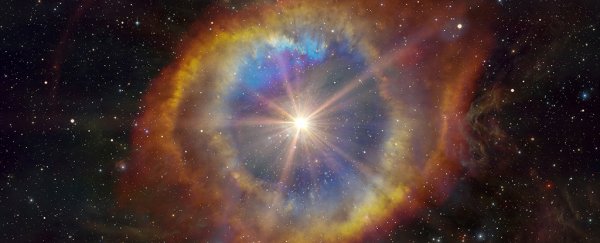Stars aren't supposed to come back to life after the death throes of the supernova stage, but astronomers have spotted three that have done just that – surviving the catastrophic explosion that usually marks the end of a star's life, and heading off through the galaxy on a new adventure.
These peculiar 'zombie' stars move a lot faster than the undead humans you might be familiar with from film and TV, and astronomers think they might be a completely new class of star.
Zombie stars like these are rare but not unheard of: another similar cosmic object, called LP 40-365, was spotted back in 2017. The three new zombie stars highlighted in a newly published study seem to have a lot in common with LP 40-365, including their relatively large size but relatively low mass.
"Our new observations strongly support the interpretation that the new stars, like LP 40-365, are the partly burnt white dwarf accretors that survived disruption from a thermonuclear supernova in a single-degenerate scenario," write the researchers.
Scientists are now hypothesising that a new class of supernova – called a Type Iax supernova – may leave behind something of the white dwarf star that started erupting in the first place, perhaps because the final explosion is weaker or different in some way.
The thinking goes that as two stars combine to form a Type Iax supernova, the crucial nuclear fusion only occurs inside a specific bubble, which means some of the matter escapes. It's just a hypothesis for now, but the new stars are more evidence for it.
Our newly spotted stars – J1603−6613, J1825−3757, and J0905+2510 – have atmospheres primarily made up of neon, oxygen and magnesium, the astronomers report, which is unusual but fits with what would be expected of a supernova survivor. It seems a lot of the star burned away, but something was left.
"It's like they tried to go supernova and didn't quite make it," astrophysicist Ashley Pagnotta from the College of Charleston in South Carolina, who wasn't involved in the new study, told New Scientist. "They came through the flames and out the other side."
There's still a lot we don't know about these runaway or zombie stars, not least how old they are, but the find is encouraging for the researchers. The team was specifically looking for stars of this type – with particularly low mass and high velocity – using observations from the Gaia space telescope and other sources.
It's possible that there could be more stars like this to discover and a lot more to learn about them: the astronomers are suggesting more theoretical work needs to be done alongside fresh deep space observations to help pin down whether these objects really do represent a new class of star.
And if that's the case, scientists could work backwards to understand more about how supernova explosions work, why they might not always destroy all traces of their originating star, and the impact that has on the wider Universe.
"The discovery of new LP 40−365 stars will be useful to further constrain their evolution, supplying key boundary conditions to the modelling of explosion mechanisms, supernova rates, and nucleosynthetic yields of peculiar thermonuclear explosions," concludes the team in their paper.
The research has been published in the Monthly Notices of the Royal Astronomical Society.
